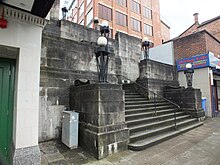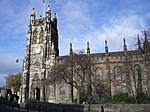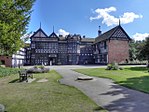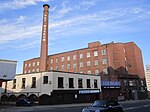Plaza Cinema, Stockport
| Plaza Super Cinema and Variety Theatre | |
|---|---|
 The Plaza from Mersey Square | |
| General information | |
| Town or city | Stockport |
| Country | England |
| Coordinates | 53°24′41″N 2°09′26″W / 53.4113°N 2.1572°W |
| Construction started | 1932 |
| Completed | 1933 |
| Opened | 7 October 1932 |
| Owner | Stockport Plaza Trust |
| Technical details | |
| Structural system | Brick and steel |
| Design and construction | |
| Architect(s) | William Thornley |
| Designations | |
Listed Building – Grade II* | |
| Official name | Plaza Cinema |
| Designated | 12 March 1997 |
| Reference no. | 1257697 |
| Other information | |
| Seating capacity | 1,314 (seated) |
| Website | |
| stockportplaza | |


The Plaza is a Grade II* listed[1] art deco single-screen cinema and theatre in Stockport, Greater Manchester, England. It opened in 1932, its construction having involved the excavation of the sandstone cliff behind it. After an initial closure in 1966 and a subsequent period in use as a bingo hall by Rank Leiure, it has now been restored as a cinema and theatre, showing films and staging live shows.
Building[edit]
The building was designed in 1929 by William Thornley and constructed in 1932–33. It is in the Art Deco style, and is of brick, with much internal structural steelwork, and with its front elevation clad in faience, a glazed architectural terracotta.[1] It contains a double-height auditorium with a gallery and small stage. The auditorium is decorated with vaguely Greek and Egyptian plasterwork and mouldings, including a broad proscenium arch, pilasters with Corinthian capitals, and friezes of dancing maidens and musical instruments. Many motifs were derived directly from the 1925 Paris Exhibition of Decorative Arts. These features were enhanced by a sophisticated concealed Holophane lighting system, fragments of which survive.[1] It had an original seating capacity of around 1,873, and in its restored state has 614 seats in the stalls, 318 in the front circle and 254 in the rear circle (the balcony).[2]
There is also a foyer with a long, first-floor restaurant above, overlooking Mersey Square. It was listed in 1997 at Grade II* by Historic England. It is described as a "remarkably lavish exercise in the Art Deco style", and an "exceptionally complete example of a 1930s 'super' cinema, which survives little altered and retains its Compton organ".[1]
Compton theatre organ[edit]
The Plaza's original organ is still in situ. It was built by the John Compton Organ Company and was ready in time for the opening of the cinema on 6 October 1932. It was the first Compton theatre organ to be built with sunburst decorative glass panels, which can be illuminated in a range of colours, and is now one of the very few that remains in its original location.[3]
The Compton organ is a three-manual instrument with a unique 150 stop tab layout which was designed for the Plaza by Norman Cocker, the resident organist from Manchester Cathedral, and Arthur Ward, one of the original Directors of the Plaza. It has in addition 42 toe and thumb pistons.[4] There are 11 ranks of pipes contained in two chambers, one over the other to the right of the stage. These are concealed behind the decorative grille in the wall. There is no electric amplification, as the sound is produced acoustically straight from the organ pipes. The console is on a lift so that it can rise out of the floor, adding to the theatrical effect. As there is no amplification the organist controls the volume using swell pedals that operate shutters in the grille. It was played before shows, and during silent movies, variety shows and musical interludes between films. The organ can supply a large range of effects from sleigh bells to aircraft and sea sounds.[4]
History[edit]
Early history[edit]
The first plans for a cinema on this site were made speculatively by William Thornley in 1929. It was a conservative scheme that incorporated a motor garage, a billiard hall, and a restaurant all above a 1,600-seat cinema.[5] Thornley, an architect originating from Bolton who had trained with Bradshaw Gass & Hope, was experienced in designing small-scale silent film cinemas.[6]
Read, Snape and Ward, a cinema circuit which had just opened the 1,850 seat Regal Cinema 7.9 miles (12.7 km) away in Manchester Road, Altrincham, were looking for a site in central Stockport in 1931. They evaluated Thornley's speculative scheme but rejected his original design. As a condition of buying the site on Mersey Square to develop, they commissioned him to adapt the plans for the Regal Altrincham - which was designed by Drury & Gomersall and described as the 'Cathedral of the Movies' - for the smaller and more restricted Stockport site without reducing the seating capacity for 1,850 patrons.[5][a]
Although he was uncredited due to part of the sale contract, Joseph Gomersall from the Regent's team is responsible for the interior design rather than Thornley. He had travelled around Europe to sample the latest architectural trends and had a professional background in theatre design.[7]
A row of cottages previously occupying the site were purchased and demolished. A set of limestone steps was then built to connect Mersey Square with the higher-level Lawrence Street, which are now known as The Plaza Steps. 10,000 tonnes of sandstone was excavated to a depth of 42 feet (13 m) to create The Plaza and the adjacent steps, leaving the building partially underground and secured by 111 rock bolts.[8] The Plaza was welcomed by the local cinemagoers but opposed by the local business community, unhappy about the use of labourers from elsewhere while the town was still suffering from the Great Depression. Technically the cinema had all the latest equipment; the projectors that could project silent and sound stock, and a Compton organ to be played during the silent news reels. It opened as a cine-variety venue.[5]
The Plaza first opened its doors to the public on 7 October 1932, with a charity show for Stockport Infirmary. As soon as the mid-1930s, cine-variety had ended and the Plaza shows assumed the familiar pattern of one feature film and a supporting B movie. The Plaza attracted competition and by 1939 there were two further super cinemas in the town centre, and two in the suburbs.[b]
During World War II (1939–1945), being cut into the rock face led to the Plaza being considered one of the safest to shelter during an air raid. After the war, despite audiences declining nationally, the Plaza was in the 1950s refurbished with the entertainment tax relief incentive, and diversified into CinemaScope and 3D screenings.[5] As well as screening films, it staged variety acts, hosted acrobatic troupes, offered stand-up comedy, concerts and during Christmas 1960, staged its first pantomime.[7]
However, audiences declined as the 1960s went on, during a period where TV ownership was ever increasing. In July 1965, the Plaza was sold to Mecca Bingo for conversion into a bingo hall. The conversion to a bingo hall was refused by Stockport Borough Council planning committee; this ruling was then overturned by appeal to the government and Mecca proceeded with its plan. The Plaza’s final show was on 31 December 1966 and featured Jerry Lewis in Three on a Couch and Audie Murphy in The Texican.[5] The bingo hall opened in February 1967. In the 1970s the first-floor café was converted into "Samantha's" nightclub but this later converted into extra bingo seating.
By 1999, The Rank Group, which had bought Mecca in 1990, decided to close the bingo venue at the Plaza. By the time of closure, it had been listed at Grade II was the last remaining building in the Borough of Stockport still capable of full-scale theatre and entertainment use. Following a local campaign, the building was sold in March 2000 to the Stockport Plaza Trust, a newly established charity which intended to bring back the former use of showing films and staging live shows.[5]
Restoration[edit]
After sale to the Stockport Plaza Trust, the group of volunteers initially raised over £3 million to put towards some early stage restorations and the reopening of the Plaza for live shows and vintage film presentations. Its listing was upgraded to Grade II* in August 2000; the lobby, auditorium and café still feature original plasterwork in striking geometric designs along with original tiling, whilst previously lost features such as murals have either been restored or recreated. The first cinema show in December 2000 featured a performance of 42nd Street (1933) which had been the first film shown at the Plaza in 1932. The Compton organ was found to be in working order, it was powered up and a performance of 1930s singalong music was given by Nigel Ogden.
The Plaza was closed during 2009, and a £1.9 million restoration, funded by a National Lottery grant took place.[10] Volunteers restored the Plaza to its original 1932 configuration. The façade has been given a new name sign as well as red and green side panels, all constructed with neon lighting. 2017 saw the installation of new Art Deco seating for the whole auditorium, cast from the original designs.
Timeline[edit]




- Cinema
1929 (April): First scheme submitted to Stockport Corporation for the construction of Cinema, Mersey Square, Stockport.
1931: Construction of the Regal Cinema, Altrincham, designed by Drury and Gomersall for the Snape Cinema Circuit.
1932 (Oct): Cinema opens in Stockport
1937: Front Circle rake altered, balcony front raised, stage level raised
1949: Seven day programme introduced (same film for seven days)
1953 (Aug): Large 48 ft.x 18 ft. projection screen installed
1953: Stockport's first 3D film presentation at – "Sangaree"
1954: First CinemaScope presentation
1960: First pantomime, Babes in the Wood featuring the Dallas Boys
1965 (July): Purchased by the Mecca Group
1966 (Dec): Closes as a cinema[10]
- Bingo hall
1967: Modifications to the auditorium to accommodate bingo; removal of roof tiling, loss of external verandah, neon lighting and signage. Flat floor insertion at rear of stalls, and alterations to foyer. Alterations to café area.
1967 (Feb): Reopens as a bingo hall
1997 (Mar): Cinema listed Grade II by English Heritage
1999: Cinema closes as a Bingo Hall[10]
- Restored cinema
2000 (Aug): Listing upgraded to Grade II* by English Heritage
2000: Purchased by the Stockport Plaza Trust, first restorations started, and re opened for live shows and vintage film presentations. First cinema show in December 2000 featured a performance of 42nd Street which had been the first film shown at the Plaza in 1932. There was also a variety performance, and Nigel Ogden of BBC Radio 2's The Organist Entertains played the Compton Organ for a 1930s style singalong before the screening. (The organ had been found to be in full working order, only needing the power switched on to be used.)
2005: Further restoration plans begin
2007: The Heritage Lottery Fund approves an application for funding of £1.9m towards further restoration of the Plaza
2009 (Feb): Jimmy Carr officially closes the Plaza with two sell out shows and work begins on restoration and refurbishment of the Stockport Plaza
2009 (May): 'Plaza on Tour' commences – a host of events in alternative venues throughout the region during the Plaza's closure
2009 (Dec): The Plaza reopens following a £3.2 million restoration
2012 (Apr): Plaza obtains a venue licence enabling it to host wedding ceremonies, Louise Burchell and Ben Wainwright become the first to be wed at the Plaza Cinema, Stockport.[11]
2013: Front Circle rake restored and balcony front lowered to original design, stage surface renewed
2014 (Jul/Aug): Brand new Art Deco seating cast from the original designs for the entire auditorium, removing the mixed origin seating.[12]
2015 (May): Murals reinstated in balcony of Wetherlam and Little Langdale Tarn in the Lake District.[13]
2015 (Aug): Compton organ restoration including the glass panel sides, pipes and bellows.[14]
2016 (July): Murals reinstated in stalls of musical instruments which include cymbals, tambourines, wind and various string instruments.[15]
Filming location[edit]
Used as filming location, including for:
- Life on Mars (Season 2, Episode 6 – 2007)
- The Maple State, Temperate Lives (2009)[16]
- Just Henry (2011)
- Eric and Ernie (2011)
- Who Do You Think You Are? (Series 10, Episode 3; Minnie Driver – 2013)
- Messages Home: Lost films of the British Army (2016)
- Road to Wembley (2016)
- Tina and Bobby (2017)
- Time for Tea [Short Film] (2017)[17]
- Peaky Blinders (Series 5, episode 6 – 2019) as the Bingley Hall in Birmingham[18]
- Federal Charm, Can't Rule Me (2019)[19]
- Bargain Hunt (Series 54 Episode 22 – 2019)[20]
- The Stranger (2020) Netflix[21]
- Larkins – "Are We Having Any Fun Yet" (2020)[22]
- Jason Manford – "Muddle Class" (2020)[23]
- Blossoms live at the Plaza Stockport (2020)[24]
- A Certain Ratio – "Keep It Together" music video (2021)[25]
- Blossoms – "Care For" music video (2021)[26]
- Blossoms – "Ribbon Around the Bomb" Album Short Film (2022)[27]
See also[edit]
Notes and references[edit]
Notes
Footnotes
- ^ a b c d Historic England. "Plaza Cinema, Stockport (1257697)". National Heritage List for England. Retrieved 11 June 2023.
- ^ "Plaza Theatre Mersey Square, Stockport, SK1 1SP". Cinema Treasures. Cinema Treasures LLC.
- ^ "Plaza Cinema, Stockport". Compton Organs. Archived from the original on 26 December 2022. Retrieved 12 June 2023.
- ^ a b "The Plaza, Heritage & Restoration The Compton Organ". 13 January 2015. Retrieved 22 October 2015.
- ^ a b c d e f "The Plaza, Heritage & Restoration history". 13 January 2015. Retrieved 22 October 2015.
- ^ "William Thornley - Architect | Architects of Greater Manchester". manchestervictorianarchitects.org.uk. Retrieved 12 June 2023.
- ^ a b Livesey, Lauren (31 December 2020). "The Plaza: the North's Finest Super Cinema". Art Deco Society UK. Retrieved 12 June 2023.
- ^ "Tours, Trips and Ghosts". Exploring the Collection... 24 September 2013. Retrieved 12 June 2023.
- ^ "Cinema". levyboy.com.
- ^ a b c "Plaza History". Stockport Plaza Trust. Retrieved 6 May 2012.
- ^ "Stage is set for couple's musical marriage service at Stockport Plaza". Stockport Express. 11 April 2012. Retrieved 6 May 2012.
- ^ "Take a seat…..or two….or two hundred!". Stockport Plaza. 17 July 2014.
- ^ "In the name of Hilda – Our Murials (Murals) have been restored!". Stockport Plaza. 21 May 2015.
- ^ "With a glorious crescendo The Mighty Compton is officially re commissioned following extensive restoration". Stockport Plaza. 30 August 2015.
- ^ "Mural restoration works commence to bring our auditorium closer to her 1932 opening day glory". Stockport Plaza. 3 July 2016.
- ^ The Maple State 'Temperate Lives' (Brett Gregory, 2009). Archived from the original on 21 December 2021 – via youtube.com.
- ^ Time for Tea. Archived from the original on 21 December 2021 – via youtube.com.
- ^ "Peaky Blinders Films in Stockport".
- ^ Federal Charm – Can't Rule Me. Archived from the original on 21 December 2021 – via youtube.com.
- ^ "Art-Deco Super Cinema – Eric is blown away by the Stockport Plaza". 4 November 2019 – via bbc.co.uk.
- ^ Puckering, Charlotte (25 May 2021). "The famous film and TV scenes that were actually shot around Manchester".
- ^ Larkins – Are We Having Fun Yet? (Official Video). Archived from the original on 21 December 2021 – via youtube.com.
- ^ "Jason Manford".
- ^ "Blossoms. Full Live Recording from The Plaza Theatre, Stockport 11.02.2..." – via Facebook.
- ^ A Certain Ratio – Keep It Together (Official Video). Archived from the original on 21 December 2021 – via youtube.com.
- ^ Blossoms – Care For (Official Video). Archived from the original on 21 December 2021 – via youtube.com.
- ^ Blossoms – Ribbon Around The Bomb (The Film) – via youtube.com.






